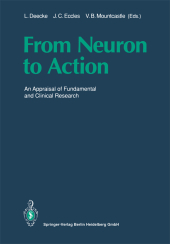 Neuerscheinungen 2012Stand: 2020-01-07 |
Schnellsuche
ISBN/Stichwort/Autor
|
Herderstraße 10
10625 Berlin
Tel.: 030 315 714 16
Fax 030 315 714 14
info@buchspektrum.de |

Lüder Deecke, John Eccles, Vernon B. Mountcastle
(Beteiligte)
From Neuron to Action
An Appraisal of Fundamental and Clinical Research
Herausgegeben von Deecke, Lüder; Eccles, John; Mountcastle, Vernon B.
Softcover reprint of the original 1st ed. 1990. 2012. xxii, 677 S. 243 SW-Abb., 1 Farbabb., 36 Tabellen
Verlag/Jahr: SPRINGER, BERLIN; SPRINGER 2012
ISBN: 3-662-02603-1 (3662026031)
Neue ISBN: 978-3-662-02603-8 (9783662026038)
Preis und Lieferzeit: Bitte klicken
A rich source of information about human voluntary movement in health and disease can be found in this book. The most esteemed researchers in their respective fields bring you up-to-date articles. Their collected work combines fundamental research in the life sciences with clinical neuroscience in a unique overview. The interdisciplinary aspects of motor physiology uncover a wealth of information for researchers from neighboring disciplines. For example, oculomotor research, vestibular research, equilibrium, sensory research and cognition, evolution, synaptic and elementary processes and the neurological sciences can be discovered.
´1: Motor.- Adaptations and Learning of Arm Movements.- Emergent Issues in the Control of Multi-joint Movements.- Looking Where the Action Is: Negative DC Shifts as Indicators of Cortical Activity.- Negative DC Shifts of the Supplementary and Motor Area Preceding and Accompanying Simultaneous and Sequential Finger Movements.- DC Potential Shifts and Regional Cerebral Blood Flow Reveal Frontal Cortex Involvement in Human Visuomotor Learning.- Event-Related Slow Potentials Recorded from Cortex and Depth of the Human Brain.- Cortical DC-Shifts Related to Sustained Sensory Stimulation and Motor Activity.- Coordination Between Posture and Movement in Parkinsonism and SMA Lesion.- Feedback Mechanisms Controlling Skeletal Muscle Tone.- Significance of Carbonic Anhydrase in the Function of Skeletal Muscle.- 2: Oculomotor and Equilibrium.- Holding the Eye Still After a Saccade.- Do the Pretectum and Accessory Optic System Play Different Roles in Optokinetic Nystagmus?.- Excitatory and Inhibitory Mechanisms Involved in the Dynamic Control of Posture During the Vestibulospinal Reflexes.- Motion Perception with Moving Eyes.- Does the System for Smooth-Pursuit Eye Movements Rely on a Neuronal Representation of Target Motion in Space?.- Optokinetic and Smooth-Pursuit Response After Adaptive Modification of the Vestibulo-Ocular Reflex.- The Detection of Motion by the Vestibular System.- Role of Neck and Visual Afferents for Self and Object Motion Perception in Labyrinthine Defective Subjects.- The Coordination Between the Lid and Eye During Vertical Saccades.- Ocular Pursuit of Sinusoidally Moving Targets: Is There a Sine Wave Generator in the Brain?.- The Role of Visual Feedback and Preprogramming for Smooth Pursuit Eye Movements: Experiments with Velocity Steps.- Positional Nystagmus of Benign Paroxysmal Type (BPPN) due to Cerebellar Vermis Lesions: Pseudo-BPPN.- Two Forms of Head-Shaking Tests in Vestibular Examination.- 3: Sensory and Cognitive.- The Parietal Visual System and some Aspects of Visuospatial Perception.- Focal Thalamocortical Rhythms as Indicators of Attentive States in the Cat.- The Sensory Neuron - Where the Action Begins.- Parallel and Complementary Organization of Cortical Eye Movement Control and Visual Perception.- Stages of Somatosensory Processing Revealed by Mapping Event-Related Potentials.- On Ideation and "Ideography".- Movement Detection and Figure-Ground Discrimination.- Influence of Complex Visual Stimuli on the Regional Cerebral Blood Flow.- DC Shifts in the Human Brain: Their Relationship to the CNV and Bereitschaftspotential.- Probability Mapping of EEG Changes due to the Perception of Music.- Program Generator Revisited: The Role of the Basal Ganglia in Language and Communication.- From Articular Nociception to Pain: Peripheral and Spinal Mechanisms.- 4: Evolution.- The Evolution of Cerebral Asymmetry.- Science, Man and Meaning.- Information and Efficiency.- A Critical Consideration of Kornhuber´s Concept of the Brain-Mind Problem.- Brain, Mind, Freedom: Beyond Metatheory, Nearer to Reality.- Neuroethological Foundations of Human Speech.- Cricket Neuroethology: A Comparative Approach to the Nervous System.- Hierarchies of Structure-Function Relationship in the Neurosciences.- Evolution and Phylogenetic Diversification of Chemical Messengers.- 5: Synaptic and Elementary Processes.- Cascade-Type Reentrance: The Major Connectivity Principle of the Neocortex.- Peripheral Axotomy Challenges the Central Motor Neuron and its Cellular Microenvironment.- Frequency and Amplitude Codes of Neuronal Signals.- Balance and Imbalance of Transsynaptic Neurotransmission as Conditions for Normal and Pathological Behaviour: Examples Only.- Behavioural Pharmacology of Brain Glutamate.- Effects of CO2 on Neuronal Functions.- The R-Wave Biography of a Brain Potential.- The Proton-Activated Sodium Current: Activation Conditions in


